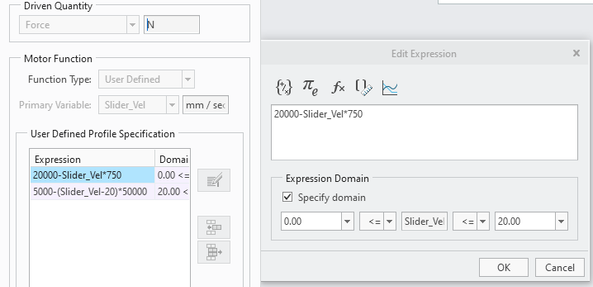- Community
- Creo+ and Creo Parametric
- 3D Part & Assembly Design
- Change velocity of servo motor according to force ...
- Subscribe to RSS Feed
- Mark Topic as New
- Mark Topic as Read
- Float this Topic for Current User
- Bookmark
- Subscribe
- Mute
- Printer Friendly Page
Change velocity of servo motor according to force applied.
- Mark as New
- Bookmark
- Subscribe
- Mute
- Subscribe to RSS Feed
- Permalink
- Notify Moderator
Change velocity of servo motor according to force applied.
Hello.
Is it possible to set the velocity of a servo motor depending on the load applied to it, inside a dynamic analysis?
For example, the linear drive (or hydraulic cylinder) below, would have a variation on velocity, depending on the angle of the arm, due to the variations on torque applied to the electrical motor (or pump).
This would go according to the motor's torque and speed curve.
And, how to give a maximum speed? It would also need a domain.
If, linear drive force F<=5000N, then Velocity (mm/s) is 20.
If, linear drive force F>5000N, then Velocity (mm/s) is 20-0,001*F
My objective is to determine predict the magnitude of the velocity of the load.
I could first get the force in function of time, got to excel and calculate the velocity in function of time, thengo back to creo and add it the servo, but this would need a few iterations and extra steps, before I get the equations correctly.
Mr. @SweetPeasHub, I have seen other thread that you participated, showing great knowledge of servo motors. Could you help me with this one?
Thanks!
Solved! Go to Solution.
- Labels:
-
Assembly Design
Accepted Solutions
- Mark as New
- Bookmark
- Subscribe
- Mute
- Subscribe to RSS Feed
- Permalink
- Notify Moderator
The independent (primary) variable has to be speed of the joint, because that can be defined before you define the force motor.
So, flip the motor curve like shown and put in the details of the curve. A function cannot have two/multiple answers so it needs some slope other than vertical. This allows the motor to apply no force at speed of 20.1 and a a reverse force if it tries to go faster than 20.1. The slope may need to be tweaked, steeper is better for the actual model but the analysis may jump too fast into a negative force for an almost vertical line. You may need a domain for negative speeds to catch everything but if you understand me so far that should be easy. Finally, you may need to make a tighter mechanism tolerance like 1e-6 as shown. (File-Prepare-Model Properties-Mechanism-->change)
- Mark as New
- Bookmark
- Subscribe
- Mute
- Subscribe to RSS Feed
- Permalink
- Notify Moderator
The independent (primary) variable has to be speed of the joint, because that can be defined before you define the force motor.
So, flip the motor curve like shown and put in the details of the curve. A function cannot have two/multiple answers so it needs some slope other than vertical. This allows the motor to apply no force at speed of 20.1 and a a reverse force if it tries to go faster than 20.1. The slope may need to be tweaked, steeper is better for the actual model but the analysis may jump too fast into a negative force for an almost vertical line. You may need a domain for negative speeds to catch everything but if you understand me so far that should be easy. Finally, you may need to make a tighter mechanism tolerance like 1e-6 as shown. (File-Prepare-Model Properties-Mechanism-->change)
- Mark as New
- Bookmark
- Subscribe
- Mute
- Subscribe to RSS Feed
- Permalink
- Notify Moderator
Hello.
Thank you, very much!
It worked perfectly.
Since I know the force variation during the whole movement, I also know the velocity domain. This allowed me to simplify, using only one equation, for now.
Resulting Force behavior
Since our main goal for the mechanism of the product was to keep the Force almost constant during the movement, the variations are small if the load doesn't change, but now we can simulate with several loads and see the variation of velocity.
Behavior with max load
Difference of velocity between maximum and zero load (only structure mass)
Now, I'll refine the Force behavior (FxVel) based on the motor Torque x angular speed to get more accurate results.
Thanks again!
- Mark as New
- Bookmark
- Subscribe
- Mute
- Subscribe to RSS Feed
- Permalink
- Notify Moderator
I am so glad to hear this worked for you!😊














